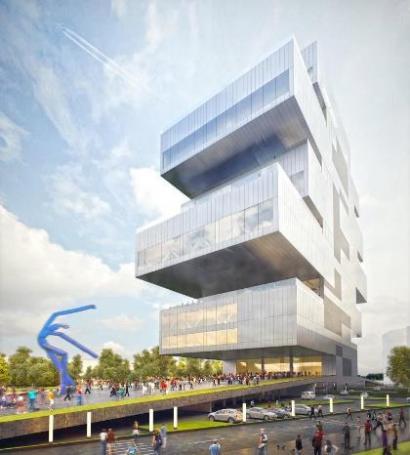
FOUNDATION STONE LAYING CEREMONY OF THE NEW MUSEUM AND EXHIBITION COMPLEX OF NCCA MOSCOW WAS HELD
4 NOVEMBER 2014
The new building will span an area of 46,500 meters and will open its doors to the public in 2018
Project of the Museum and Exhibition Complex of the NCCA ©NCCA |
NATIONAL CENTRE FOR CONTEMPORARY ARTS123242, 13, build. 2., Zoologicheskaya st., Moscow, Russia INFORMATION:• Phone: +7 (499) 254 06 74 OPENING TIMES:ADMISSION PRICE:CONTACTS:• NCCA Secretary Phone: +7 (499) 254 06 74
|
|
|
The ceremony was officially opened by Vladimir Medinsky, Minister of Culture of the Russian Federation, and Mayor of Moscow Sergey Sobyanin – co-chairs of the NCCA Board of Trustees, as well as Mikhail Mindlin, Director General of the NCCA, and member of the Federation Council of the Russian Federation, NCCA Board of Trustees member Leonid Lebedev. The ceremony was attended by representatives of the Ministry of Culture of the Russian Federation, Moscow City government, NCCA Board members, representatives of the diplomatic corps, national cultural centers, charitable foundations supporting art, and the art community – artists, curators, critics, art experts, architects, NCCA staff and friends. In his address, Minister of Culture Vladimir Medinsky called the recent competition for developing the design concept of the new NCCA building the most large-scale and well-organized architecture competition for such a museum building project in the history of modern Russia – both in terms of the number of entries and the number of shortlisted projects. “We hope that this will become one of the interesting points of attraction for residents of Moscow and its visitors,” concluded Medinsky. Mayor of Moscow Sergey Sobyanin underscored that the creation of an international-level ultra-modern museum for contemporary art is a big event in the cultural life of the capital of Russia. According to the Mayor the choice of the building site is important as well, when “global-level cultural centers are created not only in city centers but also in residential neighborhoods.” Sergey Sobyanin is confident that the new NCCA building will become the cultural epicenter of the Khodynka Field neighborhood and will ensure its overall development. NCCA Director General Mikhail Mindlin in turn said: “The new NCCA museum and exhibition complex is a very important cultural and social project for Moscow. It will become a unique Russian center for contemporary art. Our country still lacks such a center similar to those in other metropolitan cities – New York, Paris, London and others. The new NCCA will become one of the most important Russian cultural, educational and leisure centers, a new international cultural Mecca.” NCCA board member and member of the Federation Council of the Russian Federation Leonid Lebedev noted: “The new NCCA building project united a strong team of organizers, which put every effort to make sure that our country gets a modern museum and exhibition complex, so necessary for the further development of national culture. Such a museum will contribute to the immense growth of interest for contemporary art. It’s also symbolic that this event was preceded by the Federation Council’s passing of the framework law on donor activity.” Chairman of the Board of Directors of RDI Group and NCCA Board member Dmitry Aksenov also noted the importance of many aspects of this grand cultural construction: “According to its concept, the museum building will become a unique example of contemporary architecture, a work of art in and of itself, not unlike the works that it will hold. NCCA has even bigger and more ambitious goals: uniting all contemporary art movements, becoming something more than just an exhibition space – a research and education center.” Artists also contributed to the official ceremony. The Blue Noses art group (Vyacheslav Mizin and Alexander Shaburov) showed a performance, Salut; young members of the PBOYUL group presented an acoustic performance, Untitled. Elena Kovylina, in collaboration with the Krasnoyarsk Science Lab Neosvyaz, showed a performance Creatid, symbolically programming the future of the new building. Students of the PYRFYR performance school Venera Smirnova and Yuliya Neznayeva, disguised as bereginias (female spirits in Slavic mythology), performed art “rituals” and wished well-being and prosperity to the new contemporary art house. The NCCA museum and exhibition center will become the contemporary architecture centerpiece in the Khodynka Field neighborhood and organically co-exist with the landscape of the newly recreated urban park in the area. By the end of 2015 a new metro station will open in the close vicinity of the NCCA building. The new NCCA museum and exhibition complex will include halls with cutting-edge museum technology for displaying the NCCA permanent collection (today it holds around 5,000 items) and halls for temporary exhibitions. The lecture, theater, movie and conference halls will fit over 1,000 people at a time and the building will also house an information center, a public multimedia library that today holds around 8,000 publications and materials on contemporary art history, art workshops for children, residencies and workshops for artists, a café and a book/gift store. The museum and exhibition complex will be ready to host around 5,000 visitors daily. The Central Workshops for Research and Restoration Projects serve as the general designer of the building’s construction project. The architectural design is created by Archstructure and Heneghan Peng Architects (winner of the 2013 international competition for developing the design concept of the new NCCA building). The current NCCA building on Zoologicheskaya Street will be transformed into a fully fledged research, information and education complex that will host lectures, seminars and other projects on the theory and history of contemporary art. It will also house the NCCA archive, including rare books and other materials. |
||

